Enhanced Degradation of Bisphenol A via Ultrasound, Assisted by Chemical Treatment
Abstract
:1. Introduction
2. Materials and Methods
2.1. Chemicals and Equipments
Ultrasonic System
2.2. Analytical Methods Used for BPA and Intermediates Resulted
2.2.1. Analytical Conditions Used for BPA Determination
2.2.2. Analytical Conditions Used for the Identification of the Degradation Products
2.2.3. Quality Assurance and Quality Control
2.3. Work Methods
3. Results and Discussions
3.1. BPA Degradation Efficiency
3.1.1. Influence of US Frequency
3.1.2. Influence of CCl4 as Additional Compound
3.1.3. Influence of FeSO4 7H2O, FS, Additional Compounds
3.1.4. Influence of EAC as Additional Compound
3.1.5. Comparative Analyses of the BPA Transformations
4. Conclusions
Supplementary Materials
Author Contributions
Funding
Institutional Review Board Statement
Informed Consent Statement
Data Availability Statement
Acknowledgments
Conflicts of Interest
References
- Dura-Pahontu, A.M.; Draganescu, R.; Stefan, D.S.; Stefan, M. Preliminary study regarding the influence of BPA on some microorganisms. U.P.B. Sci. Bull. 2022, 84, 73–82. [Google Scholar]
- Inoue, M.; Masuda, Y.; Okada, F.; Sakurai, A.; Takahashi, I.; Sakakibara, M. Degradation of bisphenol A using sonochemical reactions. Water Res. 2008, 42, 1379–1386. [Google Scholar] [CrossRef] [PubMed]
- Loganathan, B.G.; Lam, P.K.S. Global Contamination Trends of Persistent Organic Chemicals, 1st ed.; CRC Press: Boca Raton, FL, USA, 2012; pp. 3–32. [Google Scholar]
- González-Mille, D.J.; Ilizaliturri-Hernández, C.A.; Espinosa-Reyes, G.; Cruz-Santiago, O.; Cuevas-Díaz, M.D.C.; Martín Del Campo, C.C.; Flores-Ramírez, R. DNA damage in different wildlife species exposed to persistent organic pollutants (POPs) from the delta of the Coatzacoalcos Ver, Mexico. Ecotoxicol. Environ. Saf. 2019, 180, 403–411. [Google Scholar] [CrossRef] [PubMed]
- Ghassabian, A.; Vandenberg, L.; Kannan, K.; Trasande, L. Endocrine-Disrupting Chemicals and Child Health. Annu. Rev. Pharmacol. Toxicol. 2022, 62, 573–594. [Google Scholar] [CrossRef]
- Mahmad, A.; Zango, Z.U.; Noh, T.U.; Usman, F.; Aldaghiri, O.A.; Ibnaouf, K.H.; Shaharun, M.S. Response surface methodology and artificial neural network for prediction and validation of bisphenol a adsorption onto zeolite imidazole framework. Groundw. Sustain. Dev. 2023, 21, 100925. [Google Scholar] [CrossRef]
- Preethi, S.; Sandhya, K.; Lebonah, D.E.; Prasad, C.V.; Sreedevi, B.; Chandrasekhar, K.; Kumari, J.P. Toxicity of bisphenol a on humans: A review. Int. Lett. Nat. Sci. 2014, 22, 32–46. [Google Scholar] [CrossRef]
- Suresh, S.; Singh, S.A.; Vellapandian, C. Bisphenol A exposure links to exacerbation of memory and cognitive impairment: A systematic review of the literature. Neurosci. Biobehav. Rev. 2022, 143, 104939. [Google Scholar] [CrossRef] [PubMed]
- Nikfar, E.; Dehghani, M.H.; Mahvi, A.H.; Rastkari, N.; Asif, M.; Tyagi, I.; Agarwal, S.; Gupta, V.K. Removal of Bisphenol A from aqueous solutions using ultrasonic waves and hydrogen peroxide. J. Mol. Liq. 2016, 213, 332–338. [Google Scholar] [CrossRef]
- Zhang, K.; Gao, N.; Deng, Y.; Lin, T.F.; Ma, Y.; Li, L.; Sui, M. Degradation of bisphenol-A using ultrasonic irradiation assisted by low-concentration hydrogen peroxide. J. Environ. Sci. 2011, 23, 31–36. [Google Scholar] [CrossRef]
- Chu, K.H.; Al-Hamadani, Y.A.J.; Park, C.M.; Lee, G.; Jang, M.; Jang, A.; Her, N.; Son, A.; Yoon, Y. Ultrasonic treatment of endocrine disrupting compounds, pharmaceuticals, and personal care products in water: A review. Chem. Eng. J. 2017, 327, 629–647. [Google Scholar] [CrossRef]
- Gao, Y.; Zhang, J.; Zhou, J.; Chu, W.; Gao, N. An expected formation of TCNM from chlorination of bisphenol A with ultrasonic pretreatment: A new nitrogen source for N-DBP from N2 in air. J. Chem. Eng. 2021, 429, 132326. [Google Scholar] [CrossRef]
- Meng, L.; Gan, L.; Gong, H.; Su, J.; Wang, P.; Li, W.; Chu, W.; Xu, L. Efficient degradation of bisphenol A using High-Frequency Ultrasound: Analysis of influencing factors and mechanistic investigation. J. Clean. Prod. 2019, 232, 1195–1203. [Google Scholar] [CrossRef]
- Sun, S.; Ren, Y.; Guo, F.; Zhou, Y.; Cui, M.; Ma, J.; Han, Z.; Khim, J. Comparison of effects of multiple oxidants with an ultrasonic system under unified system conditions for bisphenol A degradation. Nati. Libr. Med. 2023, 329, 138526. [Google Scholar] [CrossRef] [PubMed]
- Nath, A.; Biswas, S.; Pal, A. A comprehensive review on BPA degradation by heterogeneous Fenton-like processes. Water Sci. Tech. 2022, 86, 714–745. [Google Scholar] [CrossRef] [PubMed]
- Deggelmann, M.; Nöpel, J.A.; Rüdiger, F.; Paustian, D.; Braeutigam, P. Hydrodynamic cavitation for micropollutant degradation in water–Correlation of bisphenol A degradation with fluid mechanical properties. Ultrason. Sonochem. 2022, 83, 105950. [Google Scholar] [CrossRef]
- Li, X.; Zhang, Y.; Xie, Y.; Zeng, Y.; Li, P.; Xie, T.; Wang, Y. Ultrasonic-enhanced Fenton-like degradation of bisphenol A using a bio-synthesized schwertmannite catalyst. J. Hazard. Mater. 2018, 344, 689–697. [Google Scholar] [CrossRef] [PubMed]
- Chu, J.H.; Kang, J.K.; Park, S.J.; Lee, C.G. Ultrasound-activated peroxydisulfate process with copper film to remove bisphenol A: Operational parameter impact and back propagation-artificial neural network modeling. J. Water Process Eng. 2021, 44, 102326. [Google Scholar] [CrossRef]
- Liu, Y.C.; Liu, X.; Zhang, G.-H.; Liu, W.; Wang, J.-Q.; Wang, X.; Chen, C.L.; Wang, Y.; Xiang, Z. Performance and mechanism of a novel S-scheme heterojunction sonocatalyst CuS/BaWO4 for degradation of bisphenol A by ultrasonic activation. Environ. Res. 2023, 216, 14720. [Google Scholar] [CrossRef]
- ISO 6060:19962; Water Quality-Determination of the Chemical Oxygen Demand. International Standard ISO: Geneva, Switzerland, 1989.
- Jonathan, N.B.; Steinmetz, R. Xenoestrogens: The emerging story of bisphenol a. Trends. Endocrinol. Metab. 1998, 9, 124–128. [Google Scholar] [CrossRef]
- Torres, R.A.; Pétrier, C.; Combet, E.; Carrier, M.; Pulgarin, C. Ultrasonic cavitation applied to the treatment of bisphenol A. Effect of sonochemical parameters and analysis of BPA by-products. Ultrason. Sonochem. 2008, 15, 605–611. [Google Scholar] [CrossRef]
- Widhiastuti, F.; Fan, L.; Paz-Ferreiro, J.; Chiang, K. Oxidative treatment of bisphenol A by Fe(VI) and Fe(VI)/H2O2 and identification of the degradation products. Environ. Technol. Innov. 2022, 28, 102643. [Google Scholar] [CrossRef]
- Kang, J.H.; Kondo, F. Effects of bacterial counts and temperature on the biodegradation of bisfenol A in river water. Chemosphere 2002, 49, 493–498. [Google Scholar] [CrossRef]
- Zhang, W.; Yin, K.; Chen, L. Bacteria-mediated bisphenol A degradation. Appl. Microbiol. Biotechnol. 2013, 97, 5681–5689. [Google Scholar] [CrossRef] [PubMed]
- Kyrila, G.; Katsoulas, A.; Schoretsaniti, V.; Rigopoulos, A.; Rizou, E.; Doulgeridou, S.; Sarli, V.; Samanidou, V.; Touraki, M. Bisphenol A removal and degradation pathways in microorganisms with probiotic properties. J. Hazard. Mater. 2021, 413, 125363. [Google Scholar] [CrossRef] [PubMed]
- Zühlke, M.K.; Schlüter, R.; Mikolasch, A.; Henning, A.K.; Giersberg, M.; Lalk, M.; Kunze, G.; Schweder, T.; Urich, T.; Schauer, F. Biotransformation of bisphenol A analogues by the biphenyl-degrading bacterium Cupriavidusbasilensis-a structure-biotransformation relationship. Appl. Microbiol. Biotechnol. 2020, 104, 3569–3583. [Google Scholar] [CrossRef] [PubMed]
- Stack, D.E.; Mahmud, B. Efficient access to bisphenol A metabolites: Synthesis of monocatechol, mono-o-quinone, dicatechol, and di-o-quinone of bisphenol A. Synt. Commun. 2018, 48, 161–167. [Google Scholar] [CrossRef]
- Wua, Q.; Fanga, J.; Li, S.; Wei, J.; Yang, Z.; Zhao, H.; Zhao, C.; Cai, Z. Interaction of bisphenol A 3,4-quinone metabolite with glutathione and ribonucleosides/deoxyribonucleosides in vitro. J. Hazard. Mater. 2017, 323 Pt A, 195–202. [Google Scholar] [CrossRef]
- Deborde, M.; Rabouan, S.; Mazellier, P.; Duguet, J.P.; Legube, B. Oxidation of bisphenol A by ozone in aqueous solution. Water Res. 2008, 42, 4299–4308. [Google Scholar] [CrossRef] [PubMed]
- Gao, C.; Zeng, Y.H.; Li, C.Y.; Li, L.; Cai, Z.H.; Zhou, J. Bisphenol A biodegradation by Sphingonomas sp. YK5 is regulated by acyl-homoserine lactone signaling molecules. Sci. Total Environ. 2022, 802, 149898. [Google Scholar] [CrossRef]
- Yue, W.; Yin, C.F.; Sun, L.; Zhang, J.; Xu, Y.; Zhou, N.Y. Biodegradation of bisphenol-A polycarbonate plastic by Pseudoxanthomonas sp. strain NyZ600. J. Hazard. Maert. 2021, 416, 125775. [Google Scholar] [CrossRef]
- Reddy, P.V.L.; Kim, K.H.; Kavitha, B.; Kumar, V.; Raza, N.; Kalagara, S. Photocatalytic degradation of bisphenol A in aqueous media: A review. J. Environ. Manag. 2018, 213, 189–205. [Google Scholar] [CrossRef]
- Kang, J.H.; Kondo, F. Bisphenol A Degradation by Bacteria Isolated from River Water. Arch. Environ. Contam. Toxicol. 2002, 43, 265–269. [Google Scholar] [CrossRef]
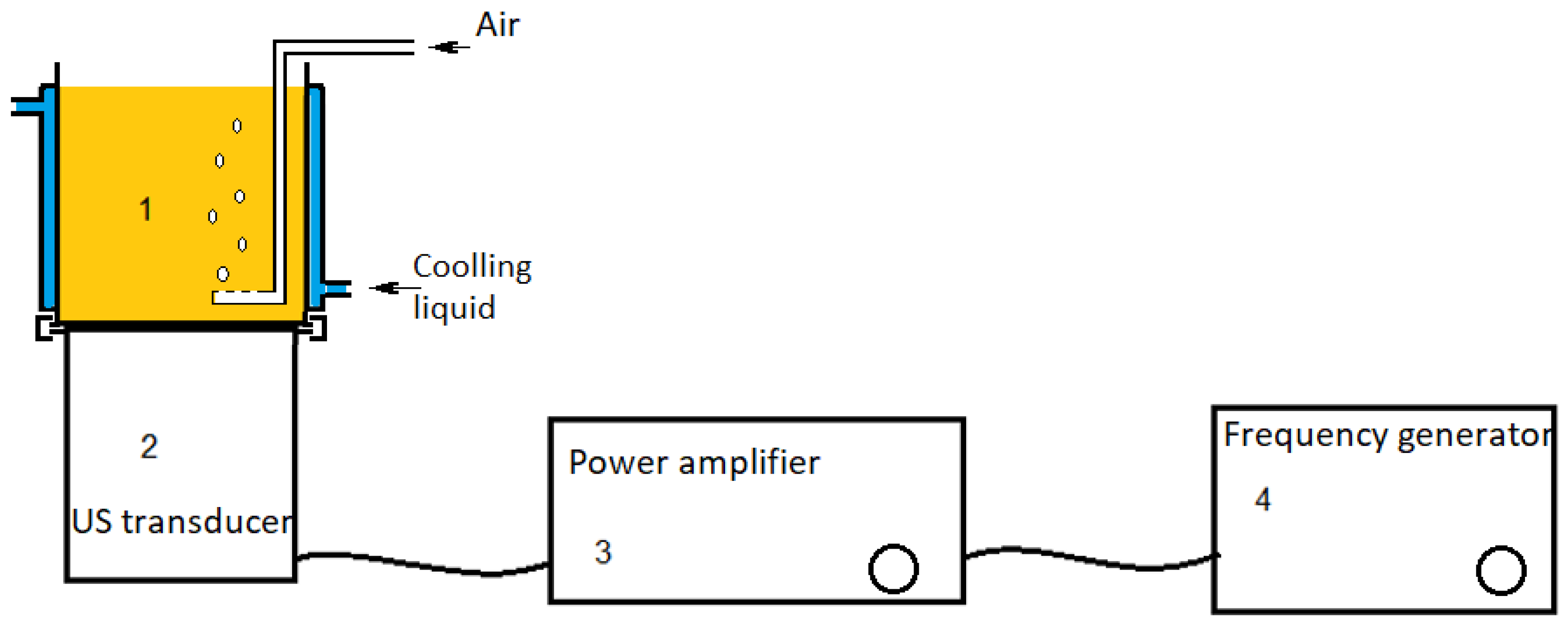
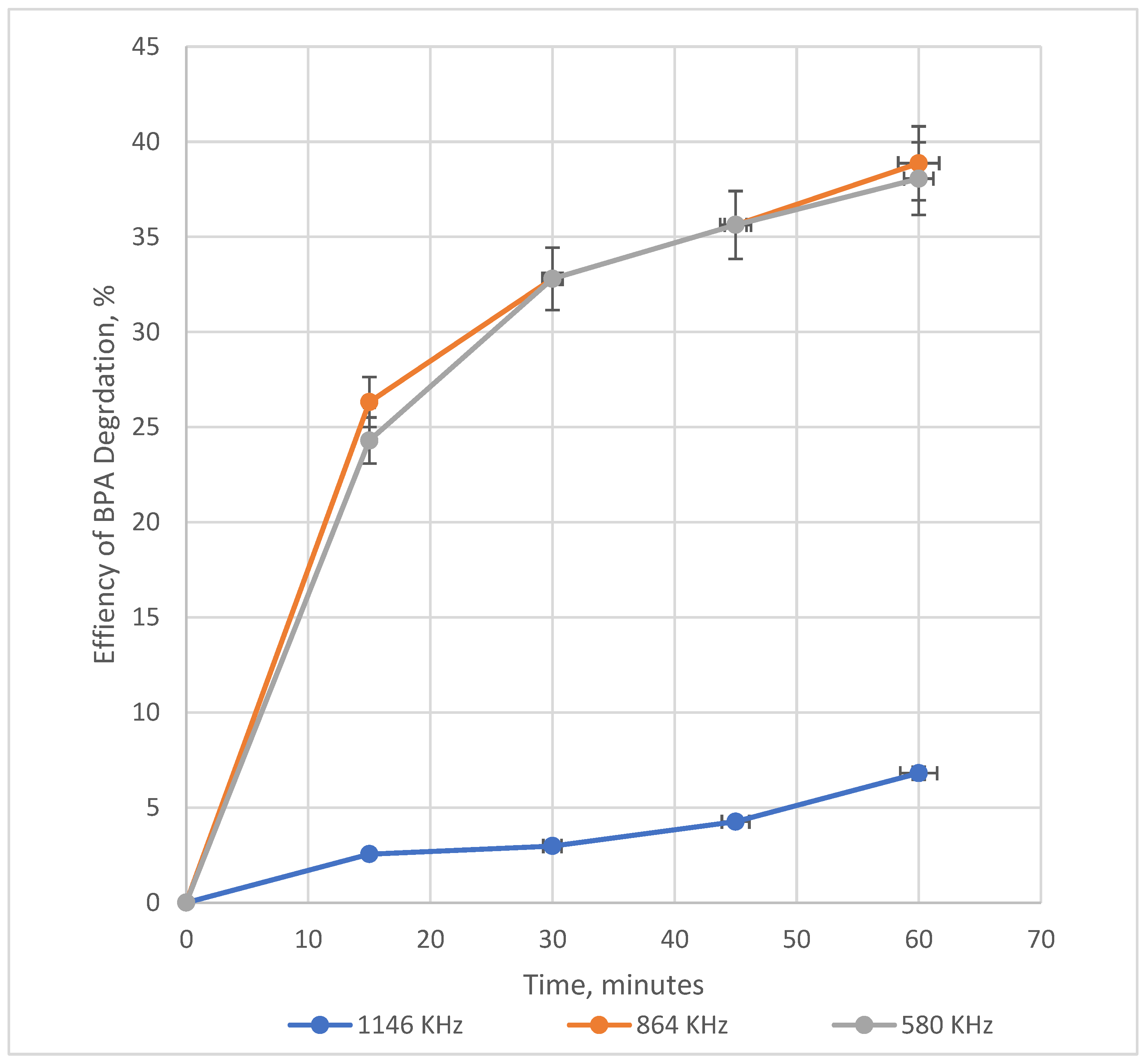
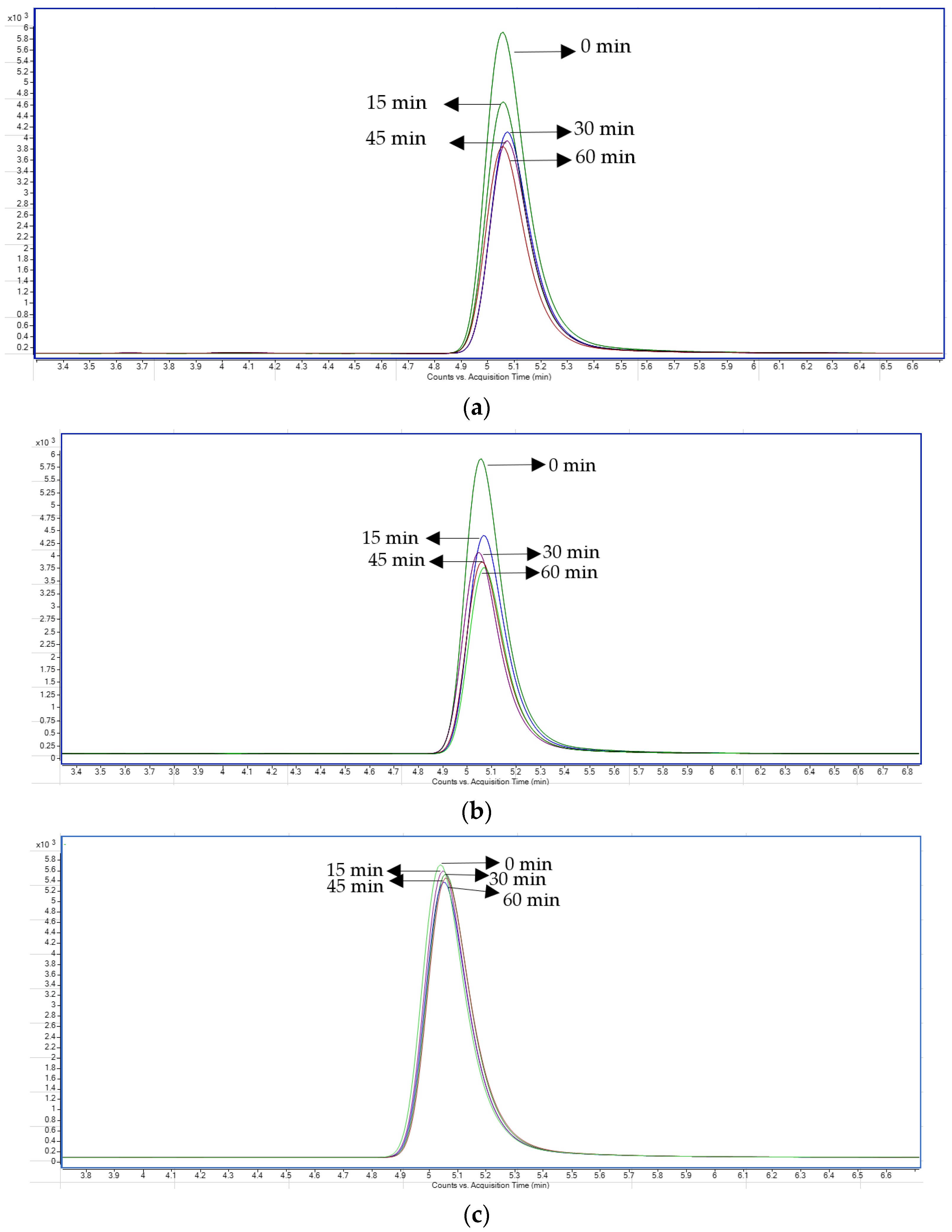
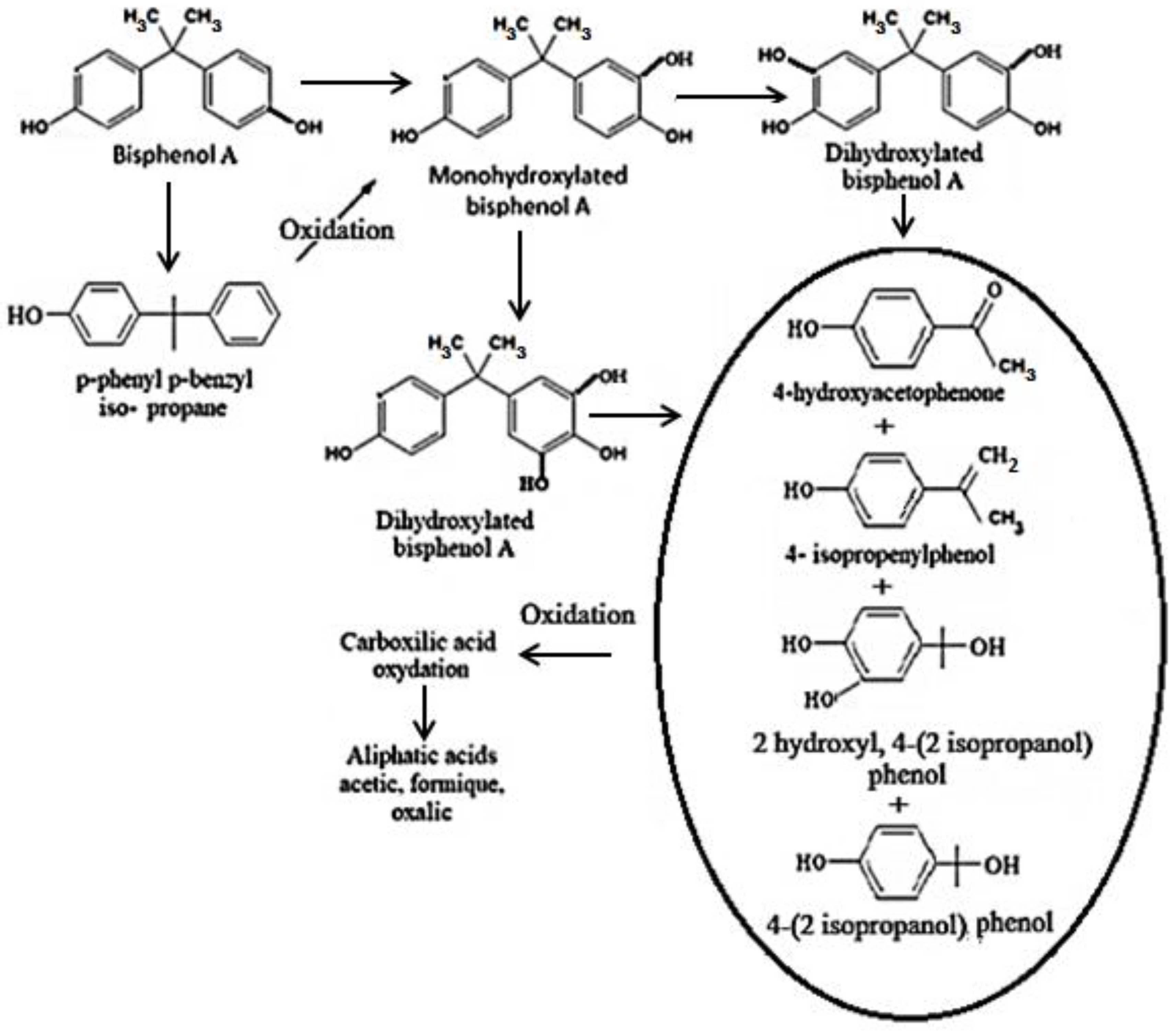
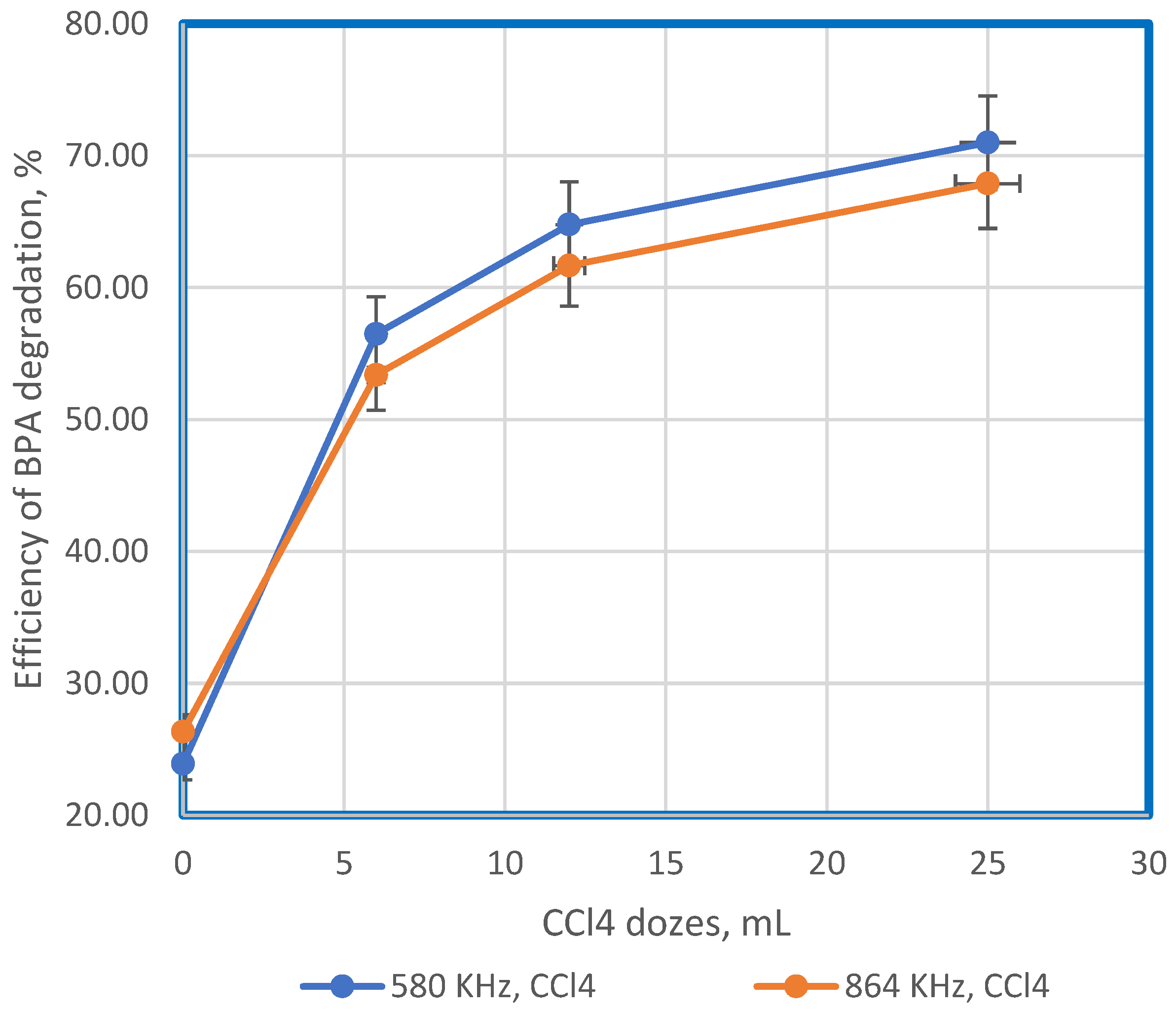
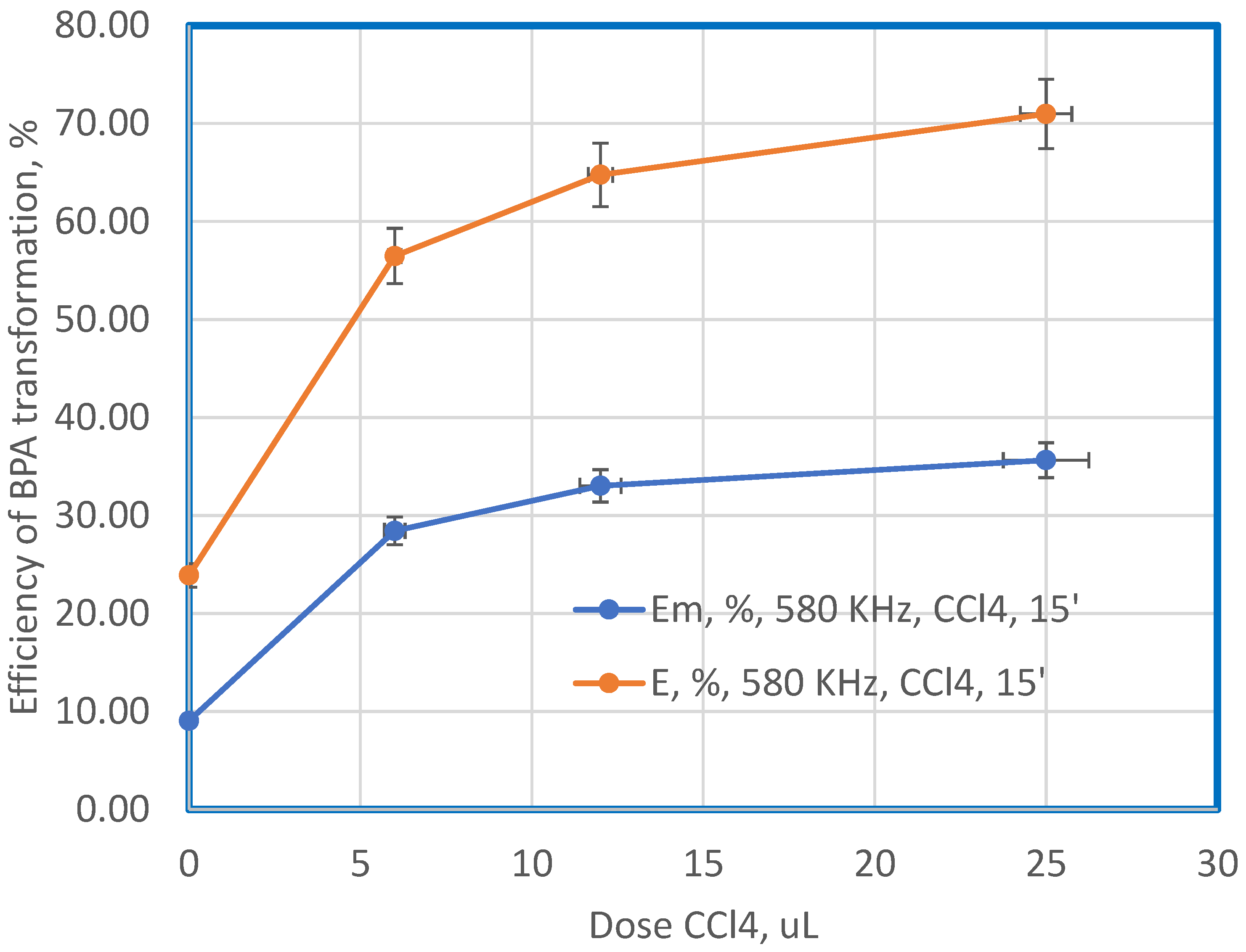

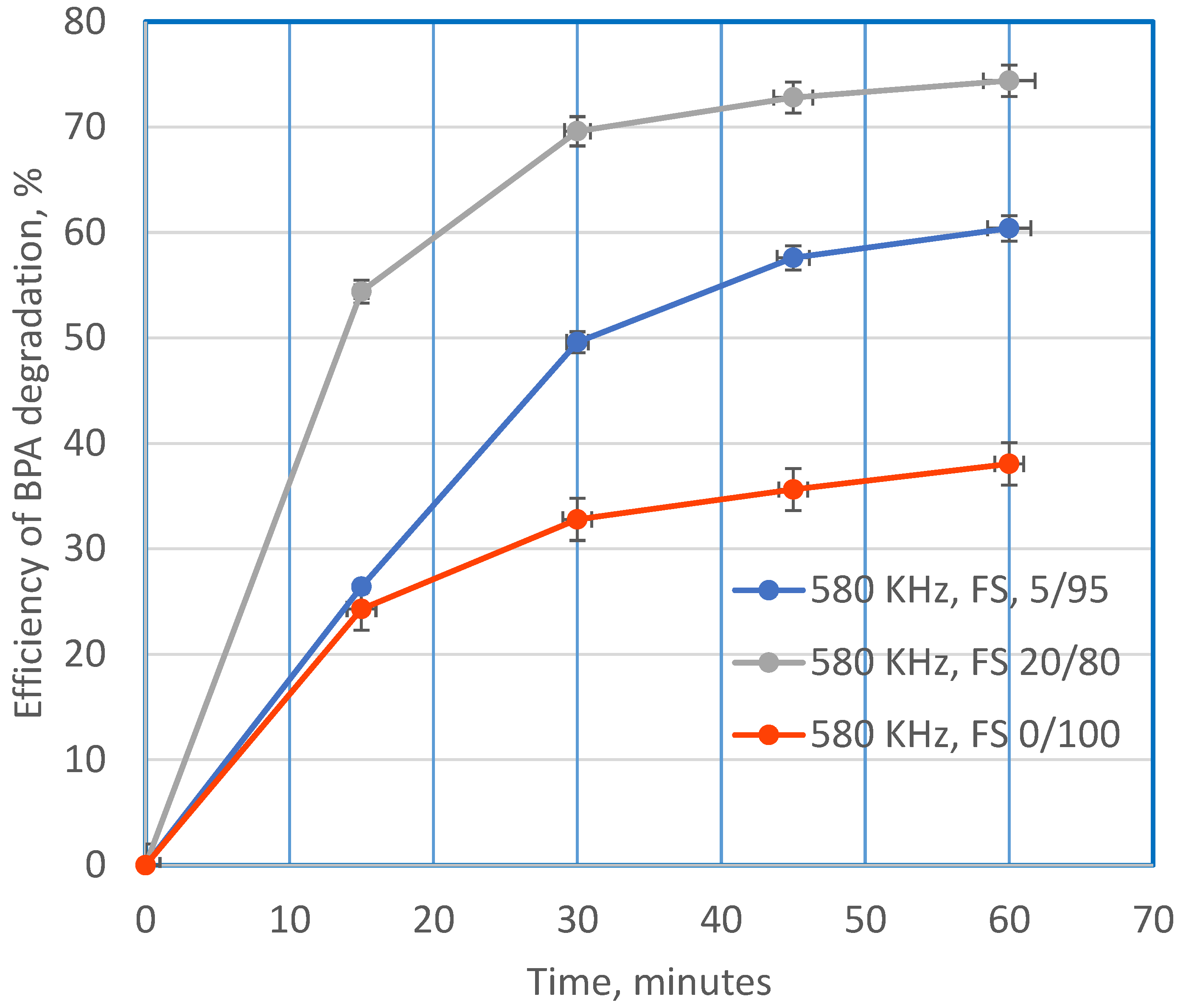
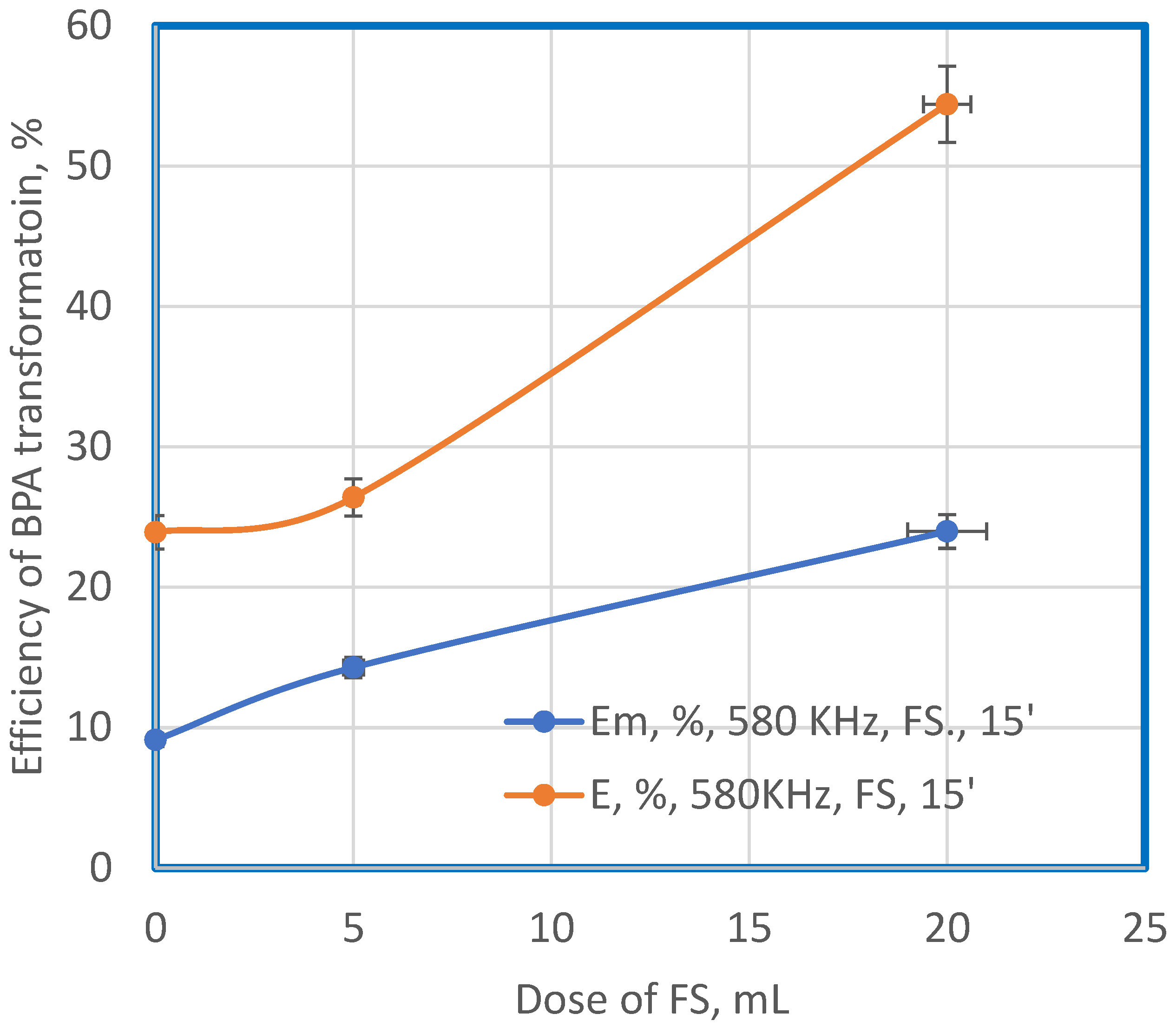

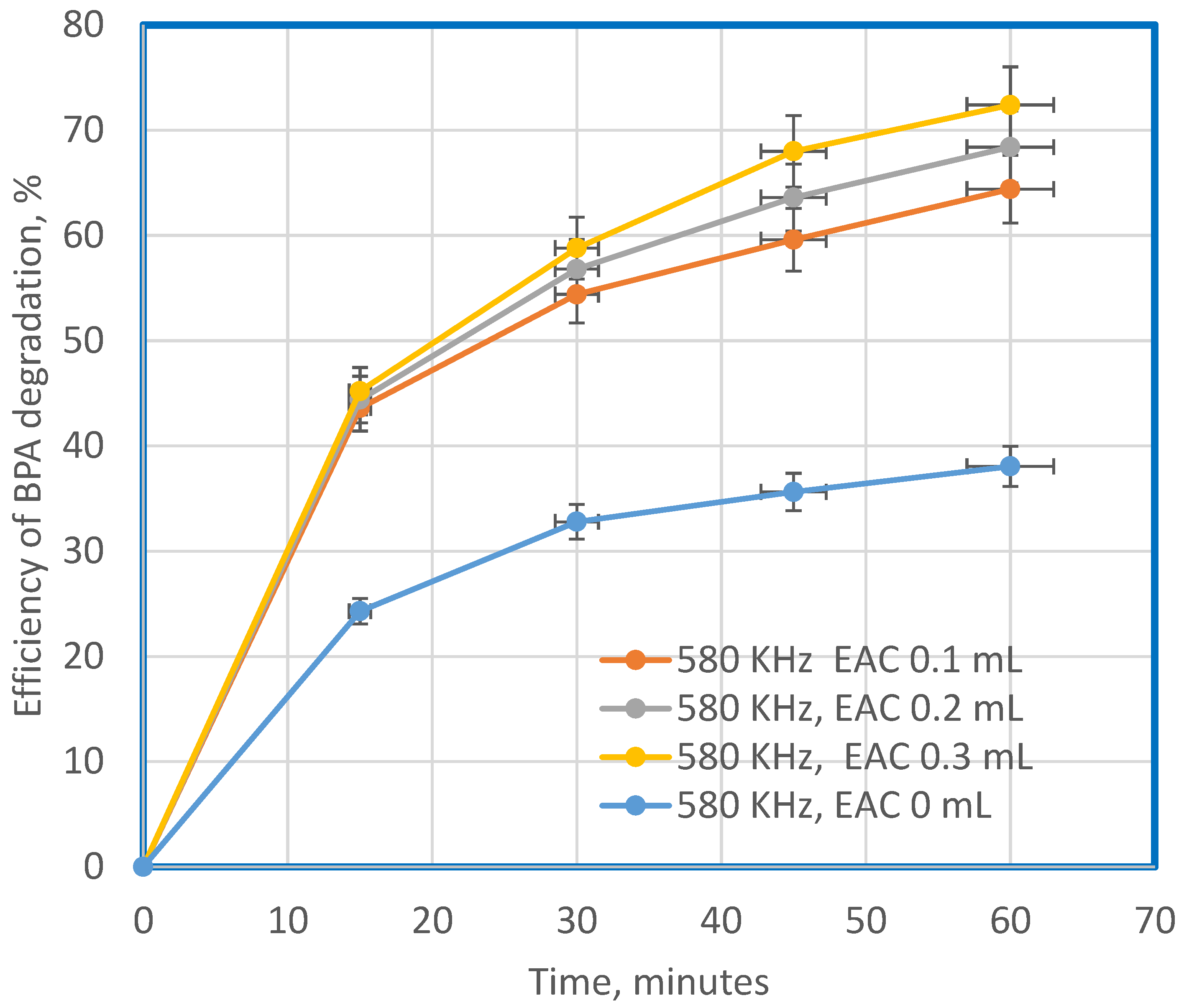
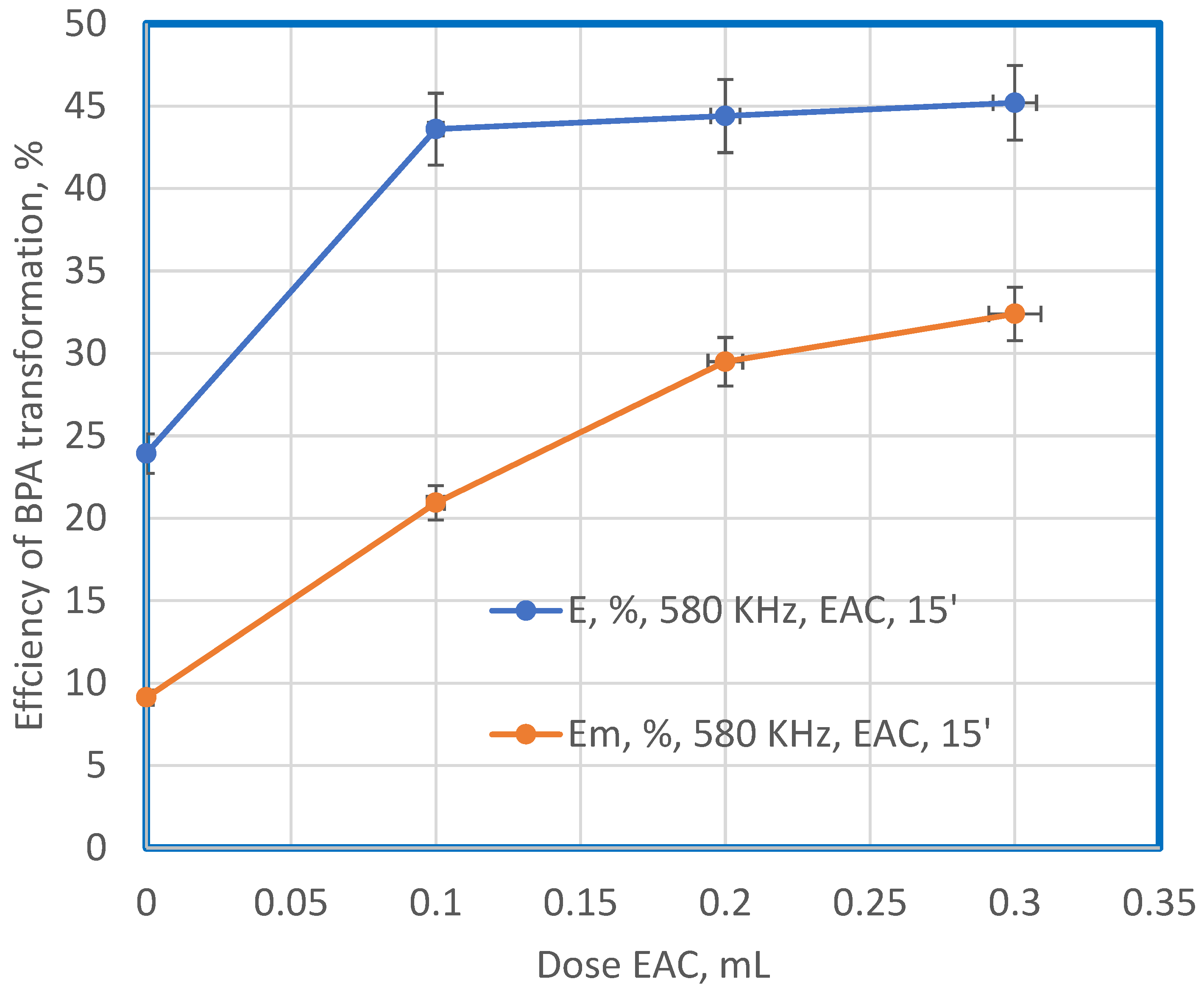
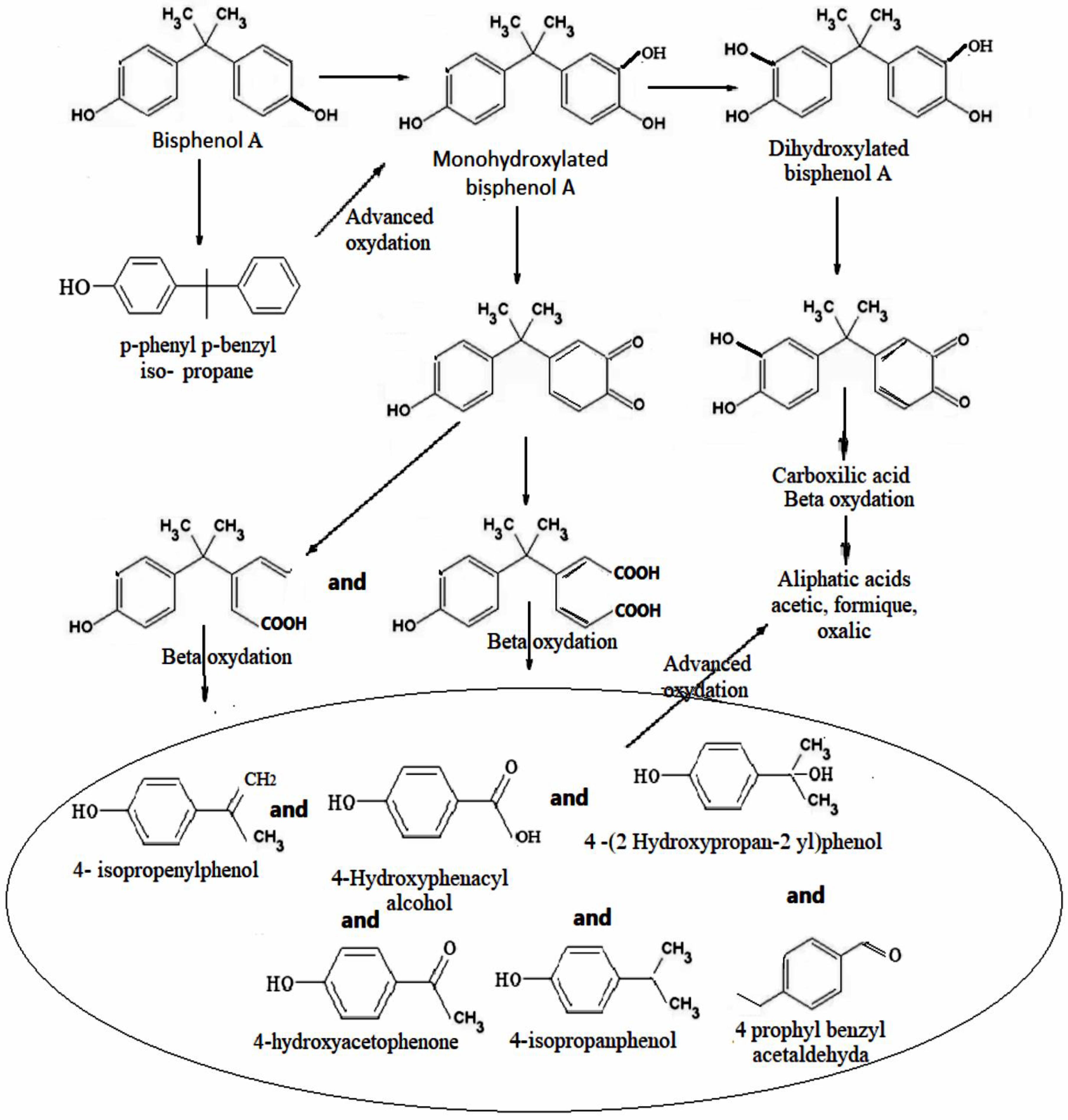

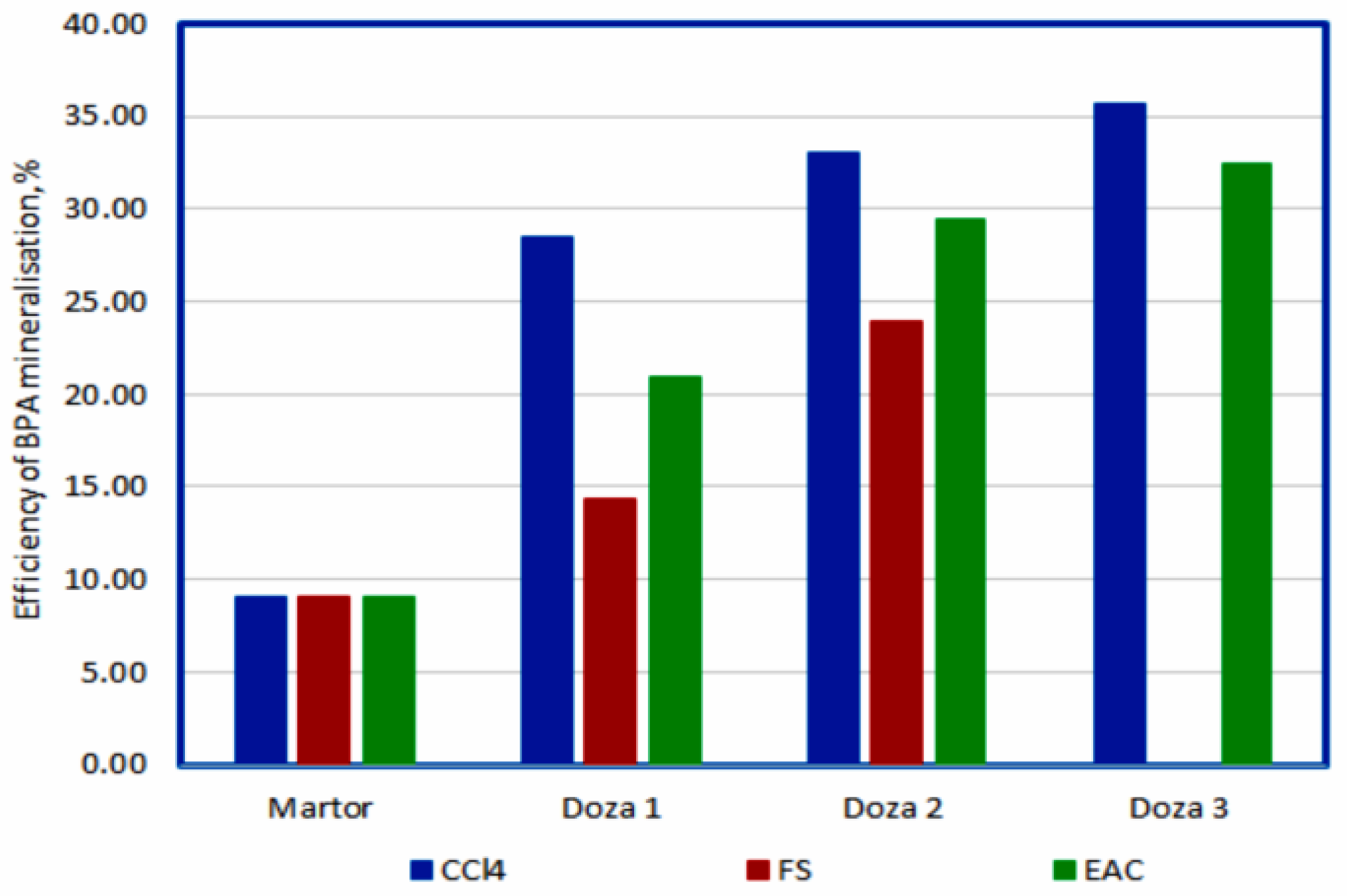
Disclaimer/Publisher’s Note: The statements, opinions and data contained in all publications are solely those of the individual author(s) and contributor(s) and not of MDPI and/or the editor(s). MDPI and/or the editor(s) disclaim responsibility for any injury to people or property resulting from any ideas, methods, instructions or products referred to in the content. |
© 2023 by the authors. Licensee MDPI, Basel, Switzerland. This article is an open access article distributed under the terms and conditions of the Creative Commons Attribution (CC BY) license (https://creativecommons.org/licenses/by/4.0/).
Share and Cite
Pahontu, A.M.; Stefan, D.S.; Chiriac, F.L.; Calinescu, I.; Dancila, A.M.; Stefan, M. Enhanced Degradation of Bisphenol A via Ultrasound, Assisted by Chemical Treatment. Sustainability 2023, 15, 14058. https://doi.org/10.3390/su151914058
Pahontu AM, Stefan DS, Chiriac FL, Calinescu I, Dancila AM, Stefan M. Enhanced Degradation of Bisphenol A via Ultrasound, Assisted by Chemical Treatment. Sustainability. 2023; 15(19):14058. https://doi.org/10.3390/su151914058
Chicago/Turabian StylePahontu (Dura), Alina Marilena, Daniela Simina Stefan, Florentina Laura Chiriac, Ioan Calinescu, Annette Madelene Dancila, and Mircea Stefan. 2023. "Enhanced Degradation of Bisphenol A via Ultrasound, Assisted by Chemical Treatment" Sustainability 15, no. 19: 14058. https://doi.org/10.3390/su151914058
APA StylePahontu, A. M., Stefan, D. S., Chiriac, F. L., Calinescu, I., Dancila, A. M., & Stefan, M. (2023). Enhanced Degradation of Bisphenol A via Ultrasound, Assisted by Chemical Treatment. Sustainability, 15(19), 14058. https://doi.org/10.3390/su151914058









